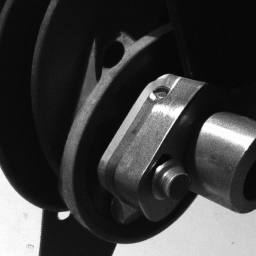
In this article, you will learn about the essential steps to maintain your garage hoist system for long-term use. With proper maintenance, you can ensure the system functions smoothly and lasts for a long time. By following these tips, you will be able to avoid costly repairs and ensure the safety of your garage hoist system.
Firstly, it is important to regularly inspect all the components of your garage hoist system. Check for any signs of wear and tear, such as frayed cables or loose bolts. Make sure to tighten any loose bolts and replace any damaged parts immediately. Additionally, you should lubricate all moving parts to minimize friction and ensure smooth operation. Secondly, it is crucial to keep the hoist system clean and free from debris. Regularly remove any dust or dirt that may accumulate on the system to prevent it from affecting its performance. Lastly, do not overload the hoist system beyond its recommended weight capacity. Overloading can cause excessive strain on the system and lead to damage or even accidents. By following these maintenance tips, you can ensure that your garage hoist system serves you well for years to come.
Regular Inspection
Regular inspection is essential to ensure the proper functioning of your garage hoist system and to prevent any potential safety hazards. Here are some key areas you should focus on during your inspections:
Checking for Wear and Tear
Inspect the overall condition of your garage hoist system for any signs of wear and tear. Look for cracks, dents, or any other visible damage on the hoist, cables, and other components. Pay attention to the load-bearing parts that are most susceptible to wear, such as the hooks and chains.
Inspecting Cables and Chains
Carefully examine the cables and chains of your hoist system for any signs of fraying or stretching. Check for kinks or knots that may compromise their functionality. Additionally, inspect the attachment points of the cables and chains to ensure they are secure and properly aligned.
Examining Pulleys and Rollers
Inspect the pulleys and rollers of your garage hoist system to ensure they are in good working condition. Look for any signs of corrosion or damage that may affect their smooth operation. Make sure they are properly lubricated and rotate freely without any obstructions.
Lubrication
Proper lubrication is crucial to maintain the smooth operation of your garage hoist system and prolong its lifespan. Here are some important lubrication points to consider:
Applying Lubricant to Moving Parts
Apply a suitable lubricant to all the moving parts of your hoist system, such as the chains, pulleys, and hooks. This will help reduce friction and ensure smooth movement during operation. Be sure to follow the manufacturer’s recommendations for the type of lubricant to use and the frequency of application.
Using Grease on Bearings
If your garage hoist system has bearings, it is important to regularly grease them to prevent friction and prolong their lifespan. Use a high-quality grease that is compatible with the specific type of bearings in your system. Apply the grease evenly to ensure optimal performance and longevity.
Ensuring Smooth Operation
After lubricating the necessary parts, test the garage hoist system to ensure smooth operation. Listen for any unusual noises or resistance during the lifting and lowering process. If you notice any issues, investigate and address them promptly to prevent further damage.
Cleaning
Regular cleaning is essential to keep your garage hoist system free from dust, debris, and other contaminants. Here are some important cleaning steps to follow:
Removing Dust and Debris
Use a soft brush or cloth to remove dust and debris from the hoist, cables, and other components. Pay special attention to hard-to-reach areas where dirt may accumulate. Avoid using excessive force or abrasive materials that may scratch or damage the surfaces.
Wiping Down the Hoist
Wipe down the hoist with a clean, damp cloth to remove any dirt or grease buildup. This will help maintain the appearance of the hoist and prevent corrosion. Avoid using harsh chemicals that may damage the painted or coated surfaces.
Cleaning the Lifting Mechanism
Inspect and clean the lifting mechanism of your garage hoist system. This includes the hooks, pulleys, and other components involved in the lifting process. Remove any dirt or debris that may hinder their proper functioning. Ensure that all parts move freely and without obstruction.
Tightening and Adjusting
Tightening and adjusting the various components of your garage hoist system is important to maintain its stability and safety. Here are some key steps to follow:
Checking Bolts and Nuts
Regularly check all the bolts and nuts on your hoist system for tightness. Make sure they are properly secured and not loose. If you notice any loose connections, tighten them using the appropriate tools, such as a wrench or socket set.
Tightening Loose Connections
In addition to checking bolts and nuts, inspect the entire hoist system for any loose connections. This includes the cables, chains, and other attachments. Tighten any loose connections according to the manufacturer’s specifications to ensure optimal performance and prevent accidents.
Adjusting Tension of Cables
Check the tension of the cables on your garage hoist system. They should be taut but not overly tight. Adjust the tension if necessary by following the manufacturer’s guidelines. Improper tension can lead to uneven lifting and decreased stability.
Replacing Damaged Parts
Over time, certain components of your garage hoist system may become damaged or worn out. It is important to identify and replace these faulty parts to maintain the safety and functionality of your hoist system. Here are some important steps to take:
Identifying Faulty Components
Regularly inspect all the components of your hoist system for any signs of damage or wear. Look for cracks, breaks, or other visible signs of deterioration. If you notice any faulty components, mark them for replacement and discontinue use until they are replaced.
Ordering and Installing Replacements
Once you have identified the faulty components, order the necessary replacements from a reliable supplier. Make sure to purchase genuine parts that are compatible with your specific hoist system. Follow the manufacturer’s instructions for proper installation to ensure the correct functioning of the new parts.
Ensuring Proper Functionality
After replacing the damaged parts, thoroughly test your garage hoist system to ensure that it functions properly. Perform a few test lifts and observe for any abnormalities or issues. If everything operates smoothly, you can resume using the hoist system with confidence.
Preventing Rust and Corrosion
Rust and corrosion can severely damage the components of your garage hoist system, compromising its safety and performance. Here are some measures you can take to prevent rust and corrosion:
Applying Rust Inhibitor
Regularly apply a rust inhibitor or protective coating to the exposed metal parts of your hoist system. This will create a barrier against moisture and prevent rust from forming. Follow the manufacturer’s instructions for the proper application of the rust inhibitor.
Protecting Against Moisture
Moisture is a major cause of rust and corrosion. Take steps to prevent moisture from coming into contact with your garage hoist system. Keep the area around the hoist dry and well-ventilated. If necessary, use dehumidifiers or moisture-absorbing agents to maintain a dry environment.
Maintaining a Dry Environment
Store your garage hoist system in a clean and dry area when not in use. Avoid exposing it to extreme temperatures or high humidity, as these conditions can accelerate rust and corrosion. Consider covering the hoist with a suitable protective cover when it is not being used for an extended period.
Safety Measures
Ensuring the safety of yourself and others when using your garage hoist system is of utmost importance. Here are some key safety measures to follow:
Following Manufacturer’s Guidelines
Always adhere to the manufacturer’s guidelines and recommendations when operating and maintaining your garage hoist system. This includes weight capacity, recommended usage, and any other safety instructions provided by the manufacturer. Failure to follow these guidelines can result in accidents and damage to the hoist system.
Using PPE (Personal Protective Equipment)
When working with your garage hoist system, always wear the appropriate personal protective equipment (PPE) to protect yourself from potential hazards. This may include safety gloves, goggles, hard hats, and other required equipment. PPE will help minimize the risk of injury during operation and maintenance tasks.
Regular Safety Inspections
Conduct regular safety inspections of your garage hoist system to ensure that all safety mechanisms are in place and functioning properly. Test emergency stop buttons, safety latches, and other safety features to verify their effectiveness. Document each safety inspection and address any issues promptly.
Proper Storage
Properly storing your garage hoist system when it is not in use is essential for its long-term use and longevity. Here are some key storage practices to follow:
Storing in a Clean and Dry Area
Store your garage hoist system in a clean and dry area to prevent dust, dirt, and moisture from accumulating on the components. Make sure the storage area is free from any potential hazards that may damage the hoist system.
Avoiding Exposure to Extreme Temperatures
Avoid exposing your garage hoist system to extreme temperatures, as this can affect its performance and lead to accelerated wear. If your hoist system is exposed to extreme heat or cold, it may expand or contract, potentially causing damage or compromising its functionality.
Protecting from UV Rays
If your garage hoist system is stored in an area exposed to direct sunlight, consider using UV protective covers or shades to protect it from the damaging effects of UV rays. UV radiation can cause plastic and rubber components to degrade over time, reducing the overall lifespan of your hoist system.
Professional Maintenance
While regular inspections and maintenance can go a long way in ensuring the longevity of your garage hoist system, seeking professional assistance is also crucial. Here are some reasons why professional maintenance is important:
Scheduling Regular Maintenance Services
Schedule regular maintenance services with a professional technician who specializes in garage hoist systems. They will have the expertise and equipment to thoroughly inspect, maintain, and repair your hoist system. Regular professional maintenance can help identify and address potential issues before they become major problems.
Seeking Expert Assistance
If you encounter any complex issues or have concerns about the performance of your garage hoist system, do not hesitate to seek expert assistance. Professional technicians can provide guidance, diagnose problems, and perform repairs or replacements if necessary. Their knowledge and experience can help ensure the safe and efficient operation of your hoist system.
Ensuring Compliance with Safety Standards
Professional maintenance services can help ensure that your garage hoist system remains compliant with the latest safety standards and regulations. These standards are designed to protect users and prevent accidents. By staying up to date with safety requirements, you can have peace of mind knowing that your hoist system is operating in a safe and compliant manner.
Conclusion
Maintaining your garage hoist system for long-term use requires regular inspection, lubrication, cleaning, tightening and adjusting, replacing damaged parts, preventing rust and corrosion, following safety measures, proper storage, and seeking professional maintenance. By following these steps, you can ensure the longevity and safety of your garage hoist system. Remember to prioritize safety at all times and consult the manufacturer’s guidelines for specific maintenance requirements. With proper care and maintenance, your garage hoist system will serve you well for years to come.









